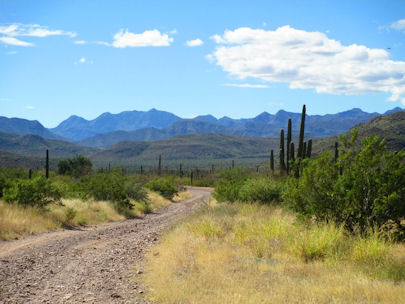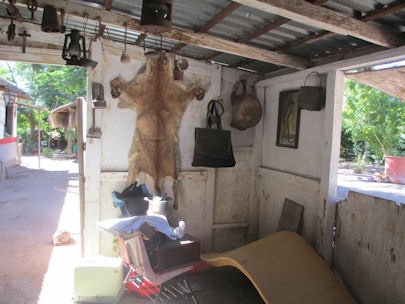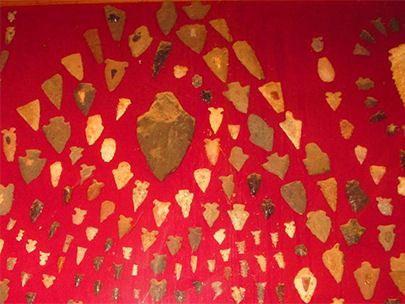 |  |

Rumor had it that there was a treasure chest full of old coins in a small museum hidden in the hills just north of Mulege, Baja Sur. Suddenly, I was in search of a story fueled by childhood thoughts of pirates and hidden treasures. By some twist of fate I found someone who could give me directions as most people didn't know of its existence. There is something about the untouched areas of Baja Sur that create an instant wanderlust. Dirt roads wind into the majestic jagged purple mountains, back-dropped by crisp blue skies and unbelievably white clouds. It sets up a yearning in the traveler's heart to leave the main road behind. Today I had a destination, I realized Doña Carlota's museum gave me a sense of knowing what I was doing and where I was going. This made me smile, as I often don't know where a story will lead and it is really like driving off into the unknown. Often it is more about the journey than the destination.
This day the warm ancient breeze lifted up hundreds of yellow butterflies chasing each other through the tall grasses. Some were settled in puddles of moisture looking like autumn leaves. A fork in the road gave me some concern, but I made a guess and chose the one-lane cut nearest the electric poles. Stopping at a humble rancho to check on my progress, I was greeted by a small wiry man with a face appearing to be etched from cowhide. Rafael said I was nearly there. Not a hundred yards down the road was the sign El Museo de Doña Carlota pointing to the right. Stopping once again, I asked a rancher tending his horses how far I had to go. He actually stopped what he was doing and motioned for me to follow him across the road to the front door. Ah, the kindness of the Mexican people.

Alejandra, a youthful senora, greeted me. Stepping inside the building was like a time warp. I could almost feel the history. Things were haphazardly displayed, rusted lanterns and mining tools hung near a six foot cougar pelt. Sunshine spilled in and touched the walls covered with photographs of Mexican movie stars. Marilyn Monroe took her place next to a luscious Mexican actress. In a second room, Alejandra proudly pointed out hundreds of arrows heads artfully designed on cloth and framed under glass. A glass case protected hundreds more. The varied sizes and uses would remain a mystery for the lay person, but certainly one could guess how the Cochimi Indians used them. These first people fished the gulf and roamed the mountains. They found everything they needed to survive, inventing their own survival tools. From the tiniest points used for rabbit, squirrel and fish up to the larger points meant for big game. Before recorded history pronghorn antelope, white tail deer and mountain sheep were in abundance. Some of the arrow heads were probably for protection. The people shared the land with mountain lions and jaguars. There were occasional conflicts with people.

Making our way outside Alejandra allowed me to just meander through all the wonders of what had been left behind. A child size metal car with wire wheels was a bit of a mystery. An industrial size Singer sewing machine was a reminder of a different era. Elias Howe had the first idea to speed up sewing, but it was Isaac Singer who capitalized the idea with the first moving parts and the use of the foot peddle, called the treadle. The two men fought over patent rights and they both became millionaires. The first part of the Industrial revolution factories in Mexico were producing sewing machines. A very impressive collection of metate with mano lay in the dappled sunlight. The “mano” is Spanish for hand and it is the smooth rounded stone that does the grinding. The southern Baja Cochimi and most Indian tribes of the Americans had this method of grinding corn, seeds and nuts according to what nature provided. The missionaries recorded that the Cochimi prized the seeds from the Pitaya cactus fruit. When the fruit was sweet and juicy, they partied and gorged themselves. After the fiesta their elimination was left to dry in the sun. In what was called the “second collecting,” the seeds were then gathered from the dusty feces, washed and ground into meal. This practice disgusted the padres.

Wandering into the shaded picnic area on my way to my car, it dawned on me that I had not found the hidden treasure. Backing tracking, Alejandra lead me back inside to a dark corner. She dusted off a metal chest and opened its squeaky lid. Old peso coins were divided into categories. It is interesting to note Wikipedia sites that the peso was originally the name of the "eight-real coins" issued in Mexico by Spain. These were the so-called Spanish dollar or "pieces of eight." The Mexican peso was widely used in the early days of the United States and by 1785 the US dollar was set to approximate the Spanish dollar.
Alas, my dreams of gold were dashed, leaving me only with a little historic romance of the Pieces of Eight and the days of the swash buckling pirates that once roamed the Gulf of California. The chest, full of forgotten coins, was a reality check about the arbitrary value we place on things and how fast that value can change.
Directions: 15 minutes from Mulege traveling north, turn left at the CRREAD sign. Follow this road 3 miles. (Watch for the fork in the road and bear to the left). Dona Carlota Museo sign is posted on the corner. Travel another .8 miles, the museum will be on your left.
Martina's email: mteomaya(at)gmail.com